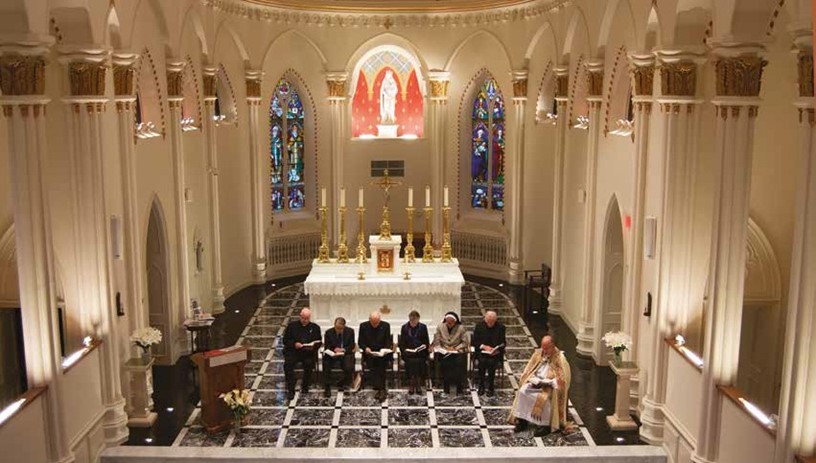Left to right: Rev Daniel F. Moore, PSS, Mr. Fritz Gollery, Rev. Richard Gula, PSS, Sr. Suzanne Dulaney, IHM, Sr. Marcia Hall, OSP, Rev. Robert F. Leavitt, PSS, and Rev. Martin J. Burnham, PSS.
The year 2019 marked the 50th anniversary of the closing of St. Mary’s Seminary on Paca Street. The Sulpician Province recognized this anniversary with a special prayer service of remembrance on October 16, 2019, during the alumni celebrations at St. Mary’s Seminary & University. Fr. Martin Burnham, PSS, as chaplain of the Paca Street chapel, presided; Fr. Daniel Moore, PSS, as First Consultor, welcomed everyone in the name of the Provincial, Fr. John Kemper, PSS, who was visiting the Sulpician African Mission; Sr. Suzanne Delaney, IHM, and Sr. Marcia Hall, OSP, representing the two communities of religious women who had their beginnings at Paca Street, shared in leading prayers. Reflections of their experience of Paca Street were given by Mr. Fritz Gollery (1959), Fr. Richard Gula, PSS, (1969), and Fr. Robert Leavitt, PSS (1964).
Paca Street! Upon simply hearing this name, Paca Street, memories of the most formative years of my seminary life flood my imagination. I love looking back on my Paca Street experience from 1967 to 1969. For here, 50 years ago, I heard my call to the Sulpician vocation. I heard my call the way vocational calls are generally heard—through fascination. We follow fascination when we see someone acting in a way which we wish we were capable of. We desire to do what we see fascinating in another.
I come from the Diocese of Erie, Pennsylvania. Our diocese has an intense commitment to Catholic schools. In my time, most priests, especially those who showed an academic ability, were assigned to be a teacher. I came to Paca Street anticipating a ministry in Erie that would have a substantial academic component to it. So, my antennae were up to find role models. When I met the Sulpicians at Paca Street, I felt like I made contact. They showed me that ministry as a teacher is a true pastoral ministry. I experienced in them, as a community of priests, enthusiastic about what they were doing, and, by all appearances, they also seemed to like one another. I found that fascinating. I apprenticed myself to them and began taking clues from how they lived as the next step for myself.
Education and formation at Paca Street were old school. That is to say, character was the objective. To form character, one of the jobs of the educator is to hold up examples—not only by being a good example yourself, but by putting students in contact with the best things humans have thought and done. In this remembrance, I want to pay tribute to the formation faculty at Paca Street for doing just that.
These men took their place as community men living in our midst, as Sulpicians do, not separated from us by living in a faculty house. They devoted themselves to the life of the community in all its forms. They were as present to the community schedule as we were expected to be.
Bill Lee was Rector then, and Bob Evers was Dean. They led as administrators in the very turbulent times of the late ’60s. They were willing to take the risk to transform seminary life to bring it in step with the times and with the renewal going on in the Church. Their courage fascinated me.
Philosophy studies brought us in touch with the great minds— Thomas “Butch” Leigh introduced us to phenomenology, Ed Connolly to Heidegger, and Joe Gallagher mined the mind of Aquinas—an excavation that uncovered the riches underlying the post-Vatican II reforms in theology. We were taught the great minds by great people.
They showed me that ministry as a teacher
is a true pastoral ministry.
Then there was Gene Walsh, John Greenalch, and Ed Frazer bringing to life the renewal going on in theology after the Council. Their enthusiasm whet my appetite to study it more deeply. The two youngest Sulpicians at that time, Pat Browne and Jim Gorman, were social scientists who tried to teach us the importance of knowing the assumptions of the culture that is shaping us and in which we would be called to minister.
And then there was Bob Gavin. Bob was not a classroom teacher. His teaching was done through the example of his Sulpician presence and pastoral charity. The power of his presence in the community was without parallel. He had an impact on everyone.
There is an old saying, “If you catch on fire with enthusiasm, people will come from miles to watch you burn.” There was something immensely impressive about the enthusiasm of the Paca people, and the Sulpician spirit there. I came from Erie to watch them burn! As I got closer to the fire, I was fascinated by the heat they generated. I wanted to catch on fire, too, and be one of them.
Now, five decades later, I realize more than I realized when I graduated in 1969 just how much I was formed by the Paca people.
My years as a Sulpician have been indelibly marked by my Paca Street experience. My fascination with the Sulpicians at Paca Street gave me an initial enthusiasm to pursue a Sulpician vocation. That fascination has sustained me for these 50 years and fascinates me still.
Richard M. Gula, PSS
Director of Personnel

